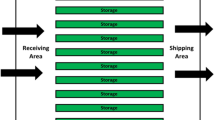Abstract
The problem considered in this paper deals with the short term scheduling of a two stage continuous process with intermediate storage tanks. The major scheduling decisions in this problem are: a) the assignment of orders to various storage tanks; b) the sequence of orders in each unit; c) the timing of various operations in different stages. The problem is highly combinatorial in nature. The major challenge is to develop strong integer programming formulations and to devise efficient solution techniques. An initial model is presented in the form of a disjunctive program which is later transformed to a Mixed Integer Linear Programming (MILP) problem. A number of example problems are solved which highlight the limitations of this model as the number of orders increases. A heuristic based on partial preordering is considered which solves industrial sized problems very quickly. The objective function values for the heuristic solutions are within 7% of the optimal values.
Similar content being viewed by others
References
J. Adams, E. Balas, and D. Zawack, “The shifting bottleneck procedure for job shop scheduling,” Management Science vol. 34, pp. 391-401, 1988.
T. E. Baker “An integrated approach to planning and scheduling,” in Foundations of Computer-Aided Pocess Operations, D. W. T. Rippin, J. C. Hale, and J. F. Davis, eds., CACHE: Austin, TX, 1994, pp. 237-251.
E. Balas “Disjunctive programming and a hierarchy of relaxations for discrete optimization problems,” SIAM J. Alg. Disc. Meth. vol. 6, pp. 466-486, 1985.
A. Brooke, D. Kendrick, and A. Meeraus, GAMS: A Users Guide., Boyd and Fraser Publishing Company: Danvers, MA, 1992, Scientific Press Series.
R. Fourer, D.M. Gay, and B.W. Kernighan, AMPL: A Modeling Language For Mathematical Programming, Boyd and Fraser Publishing Company: Danvers, MA, 1993, The Scientific Press Series.
M. G. Ierapetritou and C. A. Floudas, “Effective continuous-time formulation for short-term scheduling. 1. Multipurpose batch processes,” Ind. Eng.Chem. Res. vol. 37, no.11, pp. 4341-4359, 1998a.
M. G. Ierapetritou and C. A. Floudas, Effective continuous-time formulation for short-term scheduling. 2. Continuous and semicontinuous processes, Ind. Eng. Chem. Res. vol. 37, no. 11, pp. 4360-4374, 1998b.
ILOG CPLEX 6.5. User's Manual, ILOG, Inc.: Incline Village, NV 89451, 1999.
V. Jain and I. E. Grossmann, “Integrated scheduling in steel plants,” in AIChE Symposium Series number 320: Foundations of Computer-Aided Process Operations, J. F. Pekny and G. F. Blau, eds., CACHE, 1998, pp. 243-248.
E. Kondili, C. C. Pantelides, and R. W. H. Sargent, “A general algorithm for scheduling of batch operations-I,” Computers Chem. Engng. vol. 17 no. 2, pp. 221-227, 1993.
C. C. Pantelides, “Unified frameworks for optimal process planning and scheduling,” in Foundations of Computer-Aided Pocess Operations, D. W. T. Rippin, J. C. Hale, and J. F. Davis, eds., CACHE: Austin, TX, 1994, pp. 253-274.
J. M. Pinto and I. E. Grossmann, “A continuous time mixed integer linear programming model for short term scheduling of multistage batch plants,” Ind. Eng.Chem. Res. vol. 34, no. 9, pp. 3037-3051, 1995.
J. M. Pinto and I. E. Grossmann, “An alternate MILP model for short-term scheduling of batch plants with preordering constraints,” Ind. Eng. Chem. Res. vol. 35, no. 1, pp. 338-342, 1996.
J. M. Pinto and I. E. Grossmann, “Assignment and sequencing models for the scheduling of process systems,” Annals of Operations Research vol. 81, pp. 433-466, 1998.
R. Raman and I. E. Grossmann, “Relation between MILP modelling and logical inference for chemical process synthesis,” Computers Chem Engng. vol. 15, no. 2, pp. 73-84, 1991.
G. V. Reklaitis and L. Mockus, “Mathematical programming formulation for scheduling of batch operations based on nonuniform time discretization,” Acta Chimica Slovenica vol. 42, pp. 81-86, 1995.
G. Schilling and C. C. Pantelides, “A simple continuous-time process scheduling formulation and a novel solution algorithm,” Computers Chem. Engng. vol. 20(Suppl.), pp. S1221-S1226, 1996.
G. Schilling, Y. E. Pineau, C. C. Pantelides, and N. Shah, “Optimal scheduling of multipurpose continuous plants,” in AICHE National Meeting, San Francisco, CA, 1994.
N. Shah “Single and multisite planning and scheduling: Current status and future challenges,” in AIChE Symposium Series, vol. 320: Foundations of Computer-Aided Process Operations, J. F. Pekny and G. F. Blau, eds., CACHE, 1998, pp. 75-90.
N. Shah, C. C. Pantelides, and R. W. H. Sargent, “A general algorithm for schduling of batch operations-II,” Computers Chem. Engng. vol. 17, no. 2, pp. 229-224, 1993.
M. Türkay and I. E. Grossmann. Disjunctive programming techniques for the optimization of process systems with discontinuous investment costs-multiple size regions. Ind. Eng. Chem. Res. vol. 35, no. 8, pp. 2611-2623, 1996.
XPRESS-MP. Reference Manual, Dash Associates: Northants, U.K., 1997.
M. G. Zenter and J. F. Pekny, “Learning to solve process scheduling problems: The role of rigorous knowledge acquisition frameworks,” in Foundations of Computer Aided Pocess Operations, D. W. T. Rippin, J. C. Hale, and J. F. Davis, eds., CACHE: Austin, TX, 1994, pp. 275-309.
X. Zhang and R.W. H. Sargent, “The optimal operation of mixed production facilities-a general formulation and some approaches for the solution,” Computers Chem. Engng. vol. 20, no. 6/7, pp. 897-904, 1996a.
X. Zhang and R.W. H. Sargent, The optimal operation of mixed production facilities-extensions and improvements. Computers Chem. Engng. vol. 20(Suppl.), pp. S1287-S1293, 1996b.
Author information
Authors and Affiliations
Rights and permissions
About this article
Cite this article
Jain, V., Grossmann, I.E. A Disjunctive Model for Scheduling in a Manufacturing and Packing Facility with Intermediate Storage. Optimization and Engineering 1, 215–231 (2000). https://doi.org/10.1023/A:1010095932721
Issue Date:
DOI: https://doi.org/10.1023/A:1010095932721




